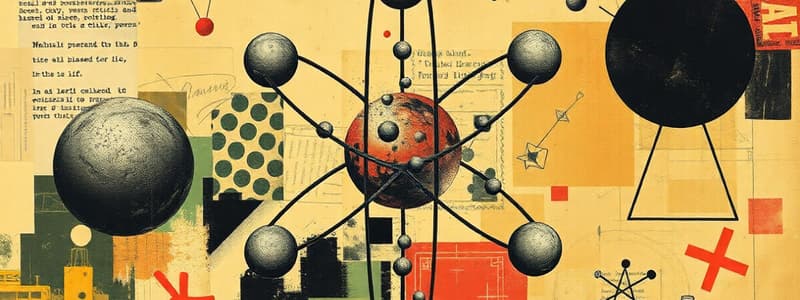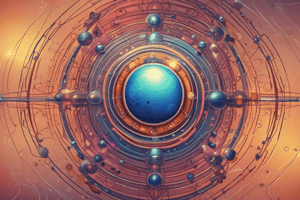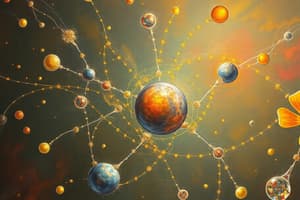Podcast
Questions and Answers
What particles are located in the nucleus of an atom?
What particles are located in the nucleus of an atom?
- Electrons and Neutrons
- Protons and Electrons
- Protons and Neutrons (correct)
- Neutrons and Charged Cloud
What does the atomic number represent?
What does the atomic number represent?
- The number of protons in the nucleus (correct)
- The number of electrons surrounding the nucleus
- The total number of particles in the atom
- The number of neutrons in the nucleus
Which statement is true about atoms?
Which statement is true about atoms?
- Atoms can gain or lose protons to become neutral.
- Atoms are electrically neutral when the number of protons equals the number of electrons. (correct)
- Atoms consist only of protons and electrons.
- Atoms of different elements can have the same number of protons.
What substance cannot be broken down into simpler substances by ordinary chemical means?
What substance cannot be broken down into simpler substances by ordinary chemical means?
In the atomic structure of Carbon (C), what is its atomic number?
In the atomic structure of Carbon (C), what is its atomic number?
What does mass refer to in the context of atomic mass?
What does mass refer to in the context of atomic mass?
How is the atomic mass of an atom determined?
How is the atomic mass of an atom determined?
What characterizes a cation?
What characterizes a cation?
What defines an anion?
What defines an anion?
Which statement is true about neutral atoms?
Which statement is true about neutral atoms?
What is the primary conclusion of the Rutherford scattering experiment?
What is the primary conclusion of the Rutherford scattering experiment?
What prediction was made regarding the behavior of alpha particles in the Rutherford experiment?
What prediction was made regarding the behavior of alpha particles in the Rutherford experiment?
What was an important aspect of scientific thinking demonstrated in the Rutherford experiment?
What was an important aspect of scientific thinking demonstrated in the Rutherford experiment?
What was a significant observation made during the Rutherford scattering experiment?
What was a significant observation made during the Rutherford scattering experiment?
How do the findings of the Rutherford experiment contribute to our understanding of atomic structure?
How do the findings of the Rutherford experiment contribute to our understanding of atomic structure?
What distinguishes isotopes of a single element from each other?
What distinguishes isotopes of a single element from each other?
What is a characteristic of radioactive isotopes?
What is a characteristic of radioactive isotopes?
What determines the chemical behavior of an atom?
What determines the chemical behavior of an atom?
According to the Bohr model, how are electrons arranged around the nucleus?
According to the Bohr model, how are electrons arranged around the nucleus?
How many electrons can occupy a single orbital?
How many electrons can occupy a single orbital?
What is the process of gaining an electron referred to in a redox reaction?
What is the process of gaining an electron referred to in a redox reaction?
Which of the following statements is true regarding oxidation?
Which of the following statements is true regarding oxidation?
According to the octet rule, how do atoms generally behave with respect to their valence electrons?
According to the octet rule, how do atoms generally behave with respect to their valence electrons?
What symbol represents the loss of electrons in a reaction?
What symbol represents the loss of electrons in a reaction?
What term is used to describe elements that are nonreactive due to having a full complement of valence electrons?
What term is used to describe elements that are nonreactive due to having a full complement of valence electrons?
What happens to an electron when it moves farther from the nucleus?
What happens to an electron when it moves farther from the nucleus?
In a redox reaction, which process is characterized as oxidation?
In a redox reaction, which process is characterized as oxidation?
Which statement correctly describes reduction in the context of redox reactions?
Which statement correctly describes reduction in the context of redox reactions?
What four elements make up 96.3% of human body weight?
What four elements make up 96.3% of human body weight?
How many naturally occurring elements are there in the periodic table?
How many naturally occurring elements are there in the periodic table?
What is the relationship between energy levels and orbitals in an atom?
What is the relationship between energy levels and orbitals in an atom?
What mnemonic can help remember the processes of redox reactions?
What mnemonic can help remember the processes of redox reactions?
What term is used to describe molecules that are composed of two or more different types of elements?
What term is used to describe molecules that are composed of two or more different types of elements?
Which elements are primarily contained in organic molecules?
Which elements are primarily contained in organic molecules?
What holds atoms together in molecules or compounds?
What holds atoms together in molecules or compounds?
What is the single most outstanding chemical property of water?
What is the single most outstanding chemical property of water?
Which factor is NOT known to influence the extent of a chemical reaction?
Which factor is NOT known to influence the extent of a chemical reaction?
In which state is water represented by glaciers?
In which state is water represented by glaciers?
Which of the following correctly describes a property of water in its gaseous state?
Which of the following correctly describes a property of water in its gaseous state?
What is a characteristic of reversible reactions?
What is a characteristic of reversible reactions?
What occurs when a sodium atom loses an electron?
What occurs when a sodium atom loses an electron?
Which type of bonding involves the sharing of electrons between atoms?
Which type of bonding involves the sharing of electrons between atoms?
What is a characteristic of molecules like H₂ that are formed through covalent bonds?
What is a characteristic of molecules like H₂ that are formed through covalent bonds?
What typically happens to ions when placed in water?
What typically happens to ions when placed in water?
What determines the strength of a covalent bond?
What determines the strength of a covalent bond?
What defines a polar covalent bond?
What defines a polar covalent bond?
In a chemical reaction, what term refers to the molecules that are formed as a result of the reaction?
In a chemical reaction, what term refers to the molecules that are formed as a result of the reaction?
Which of the following statements accurately describes electronegativity?
Which of the following statements accurately describes electronegativity?
What does the chemical equation $6H_2O + 6CO_2
ightarrow C_6H_{12}O_6 + 6O_2$ illustrate?
What does the chemical equation $6H_2O + 6CO_2 ightarrow C_6H_{12}O_6 + 6O_2$ illustrate?
What is represented by the partial positive charge ($ ext{ extdelta}^+$) in a polar covalent bond?
What is represented by the partial positive charge ($ ext{ extdelta}^+$) in a polar covalent bond?
Flashcards
Atom Structure
Atom Structure
Atoms are composed of a positively charged nucleus surrounded by negatively charged electrons.
Rutherford Experiment
Rutherford Experiment
An experiment using alpha particles to discover the atom's nucleus.
Atom Nucleus
Atom Nucleus
A small, dense, positively charged center of an atom.
Alpha Particle
Alpha Particle
Signup and view all the flashcards
Scientific Method
Scientific Method
Signup and view all the flashcards
Atomic Number
Atomic Number
Signup and view all the flashcards
Element
Element
Signup and view all the flashcards
Proton
Proton
Signup and view all the flashcards
Electron
Electron
Signup and view all the flashcards
Atomic Mass
Atomic Mass
Signup and view all the flashcards
Weight vs. Mass
Weight vs. Mass
Signup and view all the flashcards
Ions
Ions
Signup and view all the flashcards
What makes an ion?
What makes an ion?
Signup and view all the flashcards
Isotopes
Isotopes
Signup and view all the flashcards
Radioactive Isotopes
Radioactive Isotopes
Signup and view all the flashcards
Half-life
Half-life
Signup and view all the flashcards
Electron Arrangement
Electron Arrangement
Signup and view all the flashcards
Energy Levels
Energy Levels
Signup and view all the flashcards
Energy Levels in Atoms
Energy Levels in Atoms
Signup and view all the flashcards
Oxidation
Oxidation
Signup and view all the flashcards
Reduction
Reduction
Signup and view all the flashcards
Redox Reactions
Redox Reactions
Signup and view all the flashcards
Electrons in Redox
Electrons in Redox
Signup and view all the flashcards
Oxidant
Oxidant
Signup and view all the flashcards
What are the most abundant elements in the human body?
What are the most abundant elements in the human body?
Signup and view all the flashcards
What are organic molecules primarily made of?
What are organic molecules primarily made of?
Signup and view all the flashcards
Molecules
Molecules
Signup and view all the flashcards
Compounds
Compounds
Signup and view all the flashcards
Chemical Bonds
Chemical Bonds
Signup and view all the flashcards
Ionic bond
Ionic bond
Signup and view all the flashcards
Electronegativity
Electronegativity
Signup and view all the flashcards
Polar Covalent Bond
Polar Covalent Bond
Signup and view all the flashcards
Covalent bond
Covalent bond
Signup and view all the flashcards
Types of Covalent bonds
Types of Covalent bonds
Signup and view all the flashcards
Nonpolar Covalent Bond
Nonpolar Covalent Bond
Signup and view all the flashcards
Chemical Reaction
Chemical Reaction
Signup and view all the flashcards
What is an octet rule?
What is an octet rule?
Signup and view all the flashcards
Electronegativity
Electronegativity
Signup and view all the flashcards
Reactants & Products
Reactants & Products
Signup and view all the flashcards
What influences the extent of a chemical reaction?
What influences the extent of a chemical reaction?
Signup and view all the flashcards
Hydrogen bond
Hydrogen bond
Signup and view all the flashcards
Water's states
Water's states
Signup and view all the flashcards
Solid water
Solid water
Signup and view all the flashcards
Liquid water
Liquid water
Signup and view all the flashcards




